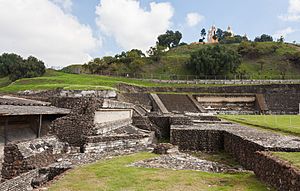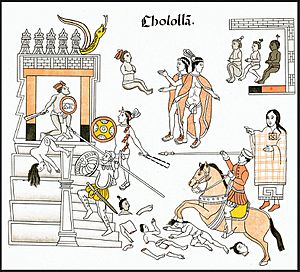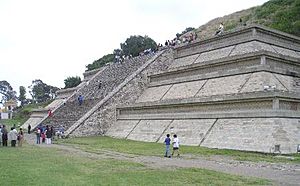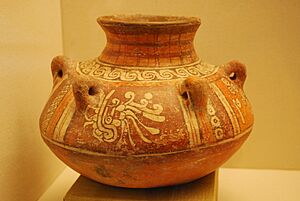Cholula (Mesoamerican site) facts for kids
Cholula (pronounced cho-LOO-lah) was a very important city in ancient Mesoamerica, a region in North and Central America. People lived here as early as 2,000 years ago! The city is located just west of the modern city of Puebla in Mexico. Cholula was a major trading spot. It is famous for its huge pyramid, the Great Pyramid of Cholula, which is the largest pyramid in the Americas and the biggest in the world by how much space it takes up.
Cholula was also one of the most important religious places in ancient Mexico.
Contents
Location and Environment
Cholula is in a valley in the central highlands of Mexico. Big, snow-covered mountains like Popocatepetl and Iztaccihuatl are to its west. Malinche mountain is to the north. The rainy summers and melted snow in winter made the land perfect for farming. Several rivers also met near the city, creating wet areas. This meant Cholula had excellent farmland. People called it the richest farming area in central Mexico.
The main crop was corn. Farmers also grew maguey plants, chiles, and a special insect called cochineal used for red dye. The soil had a lot of clay, which was great for making pottery and bricks. People also made textiles (cloth) and fancy capes.
Economy and Trade
Cholula's location was perfect for trade. It was a central point where trade routes met. These routes connected the Gulf coast, the Valley of Mexico, and other important regions. From Cholula, goods could even travel to the Pacific coast.
Because of its location, Cholula was a key link. It connected different ancient Mexican kingdoms and trade networks.
Textile Production
Making textiles was super important for Cholula's economy. During the later periods of ancient Mexico, cloth was often used as payment or for trading. People made textiles for themselves and for merchants to sell far away. We know about their textile production from old writings and things found by archaeologists.
Spanish writers from long ago noted how good Cholula's people were at dyeing threads. They could dye wool in many different colors to make beautiful fabrics. They used cotton, which probably came from the coast. They also used local materials like maguey fibers, feathers, rabbit fur, and even human hair! Archaeologists have found many small tools called spindle whorls in Cholula. These tools were used for spinning thread. Finding so many shows that textile making was a huge part of their economy.
History
Cholula started as a small village. It grew into a major city between 600 BCE and 700 CE. During this time, it was as important as the famous city of Teotihuacan. Cholula managed to avoid the violent end that Teotihuacan faced.
The earliest signs of people living here are from a very long time ago. The first parts of the Great Pyramid were built around 2,000 years ago. At that time, the city was about 2 square kilometers (about 0.77 square miles) big. Its population was probably between five and ten thousand people.
The time known as the Classic period saw the building of the Great Pyramid. Many other mounds in the city were also built then. Cholula likely covered about 5 square kilometers (about 1.9 square miles). It had an estimated population of fifteen to twenty thousand people.
Later, during the Early Postclassic period, new groups of people might have arrived. This is suggested by new art styles and a special burial found at the pyramid.
Cholula became its largest and most populated during the Postclassic period. It covered 10 square kilometers (about 3.8 square miles) and had thirty to fifty thousand people. During this time, different groups of people took control. First, a group from the Gulf Coast made Cholula their capital. They became known for making beautiful, colorful pottery that was popular all over ancient Mexico.
Around 1200 CE, another group called the Tolteca-Chichimeca took over Cholula. The main religious center moved to where the city's main plaza is today. The colorful pottery from this time still used older styles but had new designs.
Cholula remained an important city. Even when the powerful Aztec Triple Alliance was strong, Aztec princes were still formally blessed by a Cholulan priest. Sometime before 1517, Cholula was taken over by the nearby city-state of Tlaxcala.
In 1519, the Tlaxcalans, who were rivals of the Aztecs, led Hernán Cortés and his Spanish soldiers to Cholula. The Tlaxcalans wanted revenge on Cholula for joining the Aztec alliance. After a welcoming ceremony, the Spanish became suspicious. According to historical accounts, the Tlaxcalans convinced Cortés that the Cholulans were planning to attack him. Cortés then ordered an attack on the unarmed crowd in the city's main plaza. At the same time, Tlaxcala warriors rushed into the city to loot it. For four days, the Spanish and Tlaxcalans attacked and burned parts of Cholula. The Great Pyramid of Cholula was badly damaged. Cholula then rejoined the Tlaxcala alliance.
After the Spanish conquered the Aztec Empire, Cholula peacefully came under Spanish rule. A few years later, Cortés promised that a Christian church would be built for every old temple. While not every temple got a church, many churches were built. People in Cholula often say there is a church for every day of the year!
During the time Mexico was a Spanish colony, the nearby city of Puebla grew more important than Cholula.
Great Pyramid of Cholula
The Great Pyramid of Cholula, also called Tlachihualtepetl, is the largest ancient structure in the world by its total size. It was built in four main stages, one on top of the other. The first stage was about 120 meters (394 feet) on each side and 17 meters (56 feet) high.
The earliest pyramid had a special style called talud-tablero, which means it had sloping walls and flat panels. It was painted with insects in black, red, and yellow, similar to the style of Teotihuacan. The second pyramid built on top of the first one had stairs on all four sides. It measured 180 meters (590 feet) on each side. The pyramid reached its final size later, covering 16 hectares (about 40 acres) and standing 66 meters (217 feet) tall.
The pyramid and the city were built facing about 26 degrees north of west. This direction lines up with the summer solstice, which is the longest day of the year. This might have been important for worshipping a sun god.
Today, Cholula is still a very important place for pilgrimages (religious journeys) in Mexico. About 350,000 people visit the annual festival held at the top of the Great Pyramid. The Spanish built a church on top of the pyramid, which makes it the oldest continuously used building in North America! In the 1900s, archaeologists dug tunnels inside the pyramid. They found four major and nine smaller building stages. These tunnels are still open for visitors to explore.
Art
The art style of Cholula, especially its colorful pottery, shows influences from the Gulf Coast region. Colorful pottery was very common by 1000 CE.
Figurines
Figurines (small statues) are very common in Cholula. Archaeologists found many of them in an ancient water well near the University of the Americas. They found 110 figurines, and many broken pieces. They also found signs that these figurines were made nearby, like leftover clay and tools.
These figurines usually represent gods, like in many other ancient Mexican sites. But their shape is special. They are about 19 centimeters (7.5 inches) tall and show a detailed face and headdress on a simple base. The back is rough, and they often have a loop handle. Some were plain, but others had traces of colorful paint in yellow, red, black, brown, green, and pink.
In Cholula, many figurines represent the god Tlaloc, who was the god of rain. Archaeologists have found at least six different molds used to make Tlaloc figurines, each with slightly different sizes and details.
See also
 In Spanish: Zona arqueológica de Cholula para niños
In Spanish: Zona arqueológica de Cholula para niños






